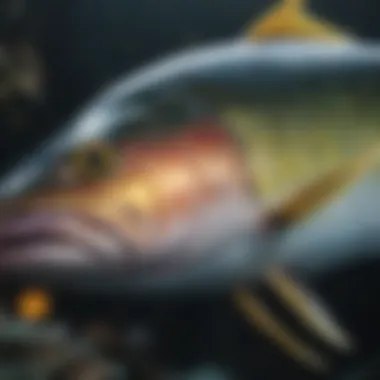Exploring the Yellowtail Fish: A Comprehensive Overview


Intro
This article aims to provide a thorough examination of the yellowtail fish. From its biological aspects to its role in fisheries and cuisine, we will discuss various factors that contribute to its significance. Understanding yellowtail is essential for many, including veterinarians, wildlife biologists, and families. We will explore its habitat, behavior, conservation status, and more to highlight its relevance in today’s ecological landscape.
Animal Overview
Common Name and Scientific Classification
The yellowtail fish, scientifically known as Seriola lalandi, belongs to the family Carangidae. This family is commonly referred to as the jacks or horse mackerels. Yellowtail is primarily known in various parts of the world, often under different local names. Such names include amberjack and kampachi, depending on the geographical region.
Physical Characteristics
Yellowtails exhibit a streamlined body covered in shimmering yellow and blue tones. This fish typically reaches lengths of around 3 to 4 feet, though some can grow larger. The distinct yellow stripe along its side is a defining trait, providing a visual cue to both predators and prey. Their muscular structure enables swift swimming, which is essential for escaping threats and pursuing prey.
Habitat and Distribution
These fish inhabit both coastal and offshore waters, favoring temperate and tropical regions. Yellowtails are commonly found in the Pacific Ocean, particularly from the North American west coast down to the waters around New Zealand. They generally prefer depths ranging from shallow to about 600 feet. Research indicates that yellowtail often congregate near underwater structures such as reefs or pinnacles, enhancing their access to prey.
Behavior and Social Structure
Communication Methods
Yellowtails communicate using various methods, including body language and vocalizations. They often exhibit behaviors like changing colors during interactions with each other or other species. Sound production has been noted, although it is less understood in their social context.
Social Hierarchies
Social structures in yellowtail populations can vary, with some evidence suggesting distinct hierarchies based on size and age. Larger individuals tend to dominate smaller ones, influencing feeding and breeding opportunities within schools. Social interactions are crucial for their survival, as it aids in hunting and protection from predators.
Mating and Reproductive Behavior
Yellowtail typically follow a seasonal spawning pattern. They engage in migrating towards warmer waters during the breeding season. They release eggs into the water column, where fertilization occurs externally. Following this, larvae must navigate through numerous challenges in their early life stages to survive to adulthood.
Conservation Status
Current Population Trends
Yellowtail populations are currently stable, although some regions are experiencing increased fishing pressures. Regular monitoring is essential to ensure sustainable practices are maintained in fisheries.
Threats and Challenges
Several threats face yellowtail fish, including overfishing and habitat degradation. The fishing industry has seen significant advancements, leading to concerns over the ecological balance of marine ecosystems they inhabit.
Conservation Efforts and Success Stories
Various organizations have initiated conservation efforts aimed at protecting yellowtail populations. These efforts include implementing quotas, establishing marine protected areas, and promoting sustainable fishing practices. Success stories often emerge from regions where these strategies have been effectively enforced. Continuous support and education regarding these practices are vital for the long-term health of yellowtail fish populations.
Adequate conservation efforts not only protect yellowtail but also help maintain the balance of marine ecosystems.
Preamble to Yellowtail Fish
Understanding the yellowtail fish is essential for anyone interested in marine biology, fishery management, and sustainable practices. This section aims to provide foundational knowledge about yellowtail, shedding light on why it is a species of significant interest. The yellowtail fish plays a vital role in various ecosystems and commercial fishing activities, making its study relevant not only for scientists but also for families and culinary enthusiasts who appreciate its importance in cuisine.


Defining Yellowtail
Yellowtail generally refers to several species within the genus Seriola, with the most well-known being the yellowtail amberjack (Seriola lalandi). This powerful fish is characterized by its streamlined body and striking yellow stripe along its lateral line. Mature yellowtail can reach lengths of up to 200 centimeters and weigh as much as 100 kilograms, showcasing a formidable presence in both the ocean and on dining plates. The name itself evokes imagery of its vibrant coloration, which has made it a sought-after catch in both recreational and commercial fishing sectors.
The defining characteristics of yellowtail fish extend beyond mere physical traits. Their migratory nature makes them adaptable to various environments, enhancing their resilience and appeal to fishers. As a species, yellowtail provides ecological balance, serving as both predator and prey within their habitat. This versatile and dynamic fish is not only significant as a food source but also as a topic of study concerning ecological interactions and evolutionary biology.
Scientific Classification
In the realm of biological classification, the yellowtail fish occupies a specific place in the broader context of marine organisms. The primary classification hierarchy for yellowtail is as follows:
- Kingdom: Animalia
- Phylum: Chordata
- Class: Actinopterygii
- Order: Perciformes
- Family: Carangidae
- Genus: Seriola
- Species: S. lalandi
This classification underscores the yellowtail's relation to other fish in the same family, including jack and pompano species. The order Perciformes, which is known for its diverse fish forms, highlights the extensive family of ray-finned fishes, indicating that yellowtails have evolved features allowing them to thrive in varying aquatic environments.
By understanding the scientific classification, readers can better appreciate the biological and ecological context of yellowtail fish. Each tier in this hierarchy provides insight into the species' behaviors, adaptive traits, and significance within marine ecosystems. This knowledge forms a crucial foundation for further exploring the biological characteristics and habitats of yellowtail fish.
Biological Characteristics
Understanding the biological characteristics of yellowtail fish is vital for gaining insights into their ecology, behavior, and their role in marine ecosystems. This segment elaborates on their physical traits, behaviors, and dietary habits, unveiling the intricate relationships that shape their existence in both natural habitats and human culinary practices.
Physical Attributes
Yellowtail fish are easily recognized by their distinctive features. The typical yellowtail has a streamlined body that aids in swift movement through the water. Their coloration often presents a vibrant yellow stripe along the length of their body, contrasting with a bluish or greenish dorsal area. Species like the California yellowtail (Seriola lalandi) can grow to lengths of 50 inches or more, weighing upwards of 100 pounds. Their size and shape play a critical role in their predatory lifestyle, allowing them to chase down prey effectively.
In addition to external coloration, yellowtail fish possess sharp, prominent dorsal and pectoral fins. These fins are essential for navigation and balance, enabling the fish to maneuver rapidly in pursuit of other fish. Their streamlined caudal fin contributes to their speed, making them formidable predators in the ocean environment.
Behavioral Traits
The behavior of yellowtail fish reflects their adaptability and survival instincts. They are known to be social creatures, often found in schools that can consist of dozens to hundreds of individuals. This schooling behavior provides safety in numbers, reducing the likelihood of predation.
Yellowtail fish exhibit significant predatory behavior, primarily feeding on smaller fish, squid, and crustaceans. Their hunting strategies often involve cooperation within schools, where they corral prey into tight spaces before launching coordinated attacks. This method increases the efficiency of their hunts, showcasing their intelligence and social dynamics.
Moreover, yellowtail are also known for their migratory patterns. They often move to deeper waters during warmer months and return towards shallower regions in cooler months. This movement is not only related to feeding but also reproduction. Understanding these behavioral patterns is crucial for fisheries management and conservation efforts.
Dietary Preferences
The dietary habits of yellowtail fish are diverse and opportunistic. As carnivorous hunters, they primarily consume a variety of marine organisms. Their diet typically includes:
- Smaller fish such as sardines and anchovies
- Squid and octopus
- Crustaceans including shrimp and crabs
This varied diet not only underscores their role as predators in the marine food web but also highlights their adaptability to changing environmental conditions. During different seasons, yellowtail may shift their feeding preferences based on the availability of prey.
Understanding the dietary preferences of yellowtail fish is essential for several reasons. It informs sustainable fishing practices and conservation strategies aimed at maintaining ecological balance. By protecting their food sources, we ensure the health and viability of yellowtail populations, which in turn supports the broader marine ecosystem.
Recognizing the biological characteristics of yellowtail fish provides essential insights into their ecological significance, feeding habits, and behavioral tendencies, all of which are crucial for informed conservation efforts.
Habitat and Distribution
The habitat and distribution section is crucial for understanding the ecological niche of yellowtail fish. These factors are not only significant for their survival but also impact fishing practices, conservation strategies, and overall ecosystem health. Recognizing where yellowtail thrive helps in sustaining their populations and maintaining balanced marine environments.
Geographical Range


Yellowtail fish are primarily found in warm waters across the Pacific and Indian Oceans. Their geographical range includes various regions that extend from the coastlines of the United States, particularly California, to the shores of Japan and Australia. This broad distribution highlights their adaptability to different marine environments.
- Pacific Ocean: Notably concentrated along the western coast of North America.
- Indian Ocean: Present near countries like Japan and Indonesia.
- Western South America: Found near the coasts of Chile and Peru.
Factors influencing this range include water temperature and salinity, which play a critical role in their migration patterns. For instance, yellowtail tend to follow warmer currents, which provide both food and favorable breeding conditions.
Preferred Environments
The preferred environments of yellowtail fish are essential to their life cycles. Generally, they inhabit coastal and offshore regions, often populating areas with abundant structures like reefs, rocky bottoms, and underwater ledges.
Some key aspects of their preferred habitats include:
- Temperature: Yellowtail prefer water temperatures typically between 18°C to 24°C.
- Depth: They are usually found at depths ranging from 20 to 200 meters, depending on the time of year and availability of food.
- Shelter: Areas with ample shelter from predators are preferred, such as kelp forests or reefs.
Maintaining these environments is critical. If suitable habitats are compromised, yellowtail populations may decline, leading to ecological imbalances.
The combination of geographical range and preferred environments reveals the adaptability of the yellowtail fish while also emphasizing the importance of protecting these critical habitats. Understanding these aspects is ultimately key to effective conservation efforts and sustainable fishing practices.
Significance in Fisheries
The significance of yellowtail fish in fisheries cannot be understated. They are not only a vital component of marine ecosystems but also play a pivotal role in economic activities related to fishing. Yellowtail fish are sought after for various reasons, including their taste, nutritional value, and the challenges they present to anglers. Understanding these elements is crucial for both sustainable fishing practices and for those who rely on this species for their livelihoods.
Fishing Techniques
When it comes to harvesting yellowtail, specific fishing techniques have proven effective. Anglers usually employ methods such as:
- Trolling: This method involves dragging a baited line behind a moving boat. Trolling is particularly effective for yellowtail due to their swift swimming speed.
- Jigging: Using weighted jigs, this technique targets yellowtail at varying depths. It requires skill and timing, making it popular among experienced fishermen.
- Live bait fishing: Utilizing live bait mimics the natural prey of yellowtail, often resulting in higher catch rates.
The choice of method impacts not only the success of a fishing expedition but also the ecological footprint of fishing activities. In addition, understanding local regulations concerning these techniques can help avoid overfishing and support sustainable practices.
Commercial Importance
Yellowtail holds considerable commercial importance across various markets. Their demand is present in the culinary sphere, particularly in regions where seafood is a staple. This fish is a popular choice in sushi and sashimi, boosting its value in international trading.
Factors contributing to their commercial significance include:
- Market Value: Fresh yellowtail can fetch high prices, especially in specialty markets. As a result, it supports local economies and contributes to livelihoods.
- Export Opportunities: Many countries export yellowtail, with significant markets in Asia and the United States. This trade enhances cultural exchange and diversifies food sources in these regions.
- Conservation Challenges: The commercial demand for yellowtail emphasizes the need for regulatory measures. Overfishing can jeopardize populations, making sustainable practices essential for future fishing endeavors.
The balance between exploiting yellowtail for economic gain and ensuring the fish's longevity in ecosystems is a challenge all stakeholders must navigate.
Culinary Uses of Yellowtail
Culinary application of yellowtail fish holds significant connotations in both the gastronomic and nutritional realms. This section delves into how yellowtail fish has established itself as a staple in various cuisines, especially in regions where it is abundantly available. Knowing its culinary uses enhances the understanding of its value not just as a food source, but also in cultural contexts.
Preparation Methods
Preparing yellowtail requires attention to detail to capture its distinct flavor and texture. Here are several popular methods:
- Sashimi: Traditionally sliced raw, yellowtail sashimi showcases the fish's buttery texture. The classic preparation involves serving it with soy sauce and wasabi.
- Grilling: Grilling brings out the rich flavor of yellowtail. Using a marinade like soy sauce, mirin, and garlic can elevate the taste. For a simple approach, just a sprinkle of salt and pepper works as well.
- Baking: Baking yellowtail is another favored method. It allows for the retention of moisture while enhancing the natural flavors. Topping it with herbs and lemon can add brightness to the dish.
- Ceviche: For a refreshing dish, ceviche can be made by marinating raw yellowtail in lime juice, combined with onions and cilantro. The acid from the lime effectively “cooks” the fish.
- Soups and stocks: Yellowtail can also be utilized in soups or stocks. The flesh adds depth and a subtle flavor to broths.
Different cultures have their own methods of preparation, and knowledge of these can broaden culinary methods.


Popular Dishes
Yellowtail is featured in numerous renowned dishes across various cuisines. Some notable ones include:
- Yellowtail Nigiri: A Japanese classic, featuring a slice of yellowtail atop a mound of vinegared rice.
- Hamakua Springs' Grilled Yellowtail: A Hawaiian dish, where the fish is grilled to perfection and served with tropical salsas.
- Yellowtail Tartare: This dish combines the fresh taste of diced yellowtail with avocados and a drizzle of sesame oil.
- Yellowtail Tacos: A modern twist that includes grilled yellowtail served with fresh salsa and cabbage slaw.
- Korean Yellowtail Porridge (Saengseon Juk): A comfort food that utilizes boiled yellowtail in a creamy rice porridge, often served with pickled vegetables.
Recognizing these popular dishes helps illustrate the versatility of yellowtail fish in different culinary traditions. It is clear that the yellowtail fish is not just a protein, but a contributing element to culinary heritage and practices.
Cultural Significance
Cultural significance of the yellowtail fish extends beyond mere consumption. Many societies deeply value this fish, integrating it into their cultural narratives and food systems. The yellowtail is not just a source of nutrition; it serves as a symbol of heritage, community, and sustainability. Ethnographic studies reveal that various cultures have rituals and practices associated with the yellowtail, reflecting respect for the sea and its resources. Understanding these aspects can enrich our appreciation of the fish and emphasize the need for responsible management practices.
Role in Traditional Diets
In numerous coastal communities, the yellowtail fish occupies a vital role in traditional diets. This species is often featured in local cuisines, providing essential nutrition, particularly in regions where other food sources are scarce. The preparation methods for yellowtail vary widely across cultures, showcasing local culinary styles.
- Japan: In Japanese cuisine, yellowtail, known as hamachi, is prized for its taste and texture. It is commonly served as sashimi or in sushi, highlighting the importance of fresh, high-quality fish in Japanese gastronomy.
- Hawaii: Hawaiian culture values yellowtail as well. It is used in traditional dishes like poke, allowing for a fusion of flavors that pays homage to both the fish and the land.
- Mediterranean Countries: In Mediterranean areas, yellowtail appears frequently in grilled or baked dishes, often paired with local vegetables and grains.
The yellowtail's rich flavor and versatility make it a staple food choice. This fish not only feeds families but also strengthens bonds within communities, as fishing and preparing yellowtail often become collective activities.
Symbolism in Various Cultures
Beyond its dietary importance, yellowtail fish holds symbolic meaning in different cultures. It often represents abundance, prosperity, and a connection to the ocean.
- Japanese Culture: In Japan, the yellowtail is associated with the New Year celebration. It symbolizes good luck and is seen as a harbinger of wealth. Offering yellowtail during festivities conveys deep cultural reverence.
- Native American Tribes: Certain Native American tribes regard fish, including yellowtail, as spiritual beings. They believe that respecting and honoring fish aligns with their values of stewardship toward nature.
- Art and Folklore: Yellowtail also appears in various forms of art and folklore in many regions. It can be found in traditional paintings, stories, and festivals that celebrate marine life, reinforcing its status within cultural narratives.
The significance of yellowtail fish transcends its biological and ecological attributes, contributing to a greater understanding of humanity's relationship with nature. Recognizing this cultural importance is essential for creating meaningful conservation initiatives aimed at preserving both the fish and the legacies of communities that cherish them.
Conservation Issues
Understanding the conservation issues surrounding yellowtail fish is crucial for maintaining ecological balance and sustainability in marine environments. Yellowtail populations are facing multiple threats that can impact their long-term viability. This section aims to outline these threats and highlight the necessary conservation efforts being undertaken to protect this vital species.
Threats to Yellowtail Populations
Yellowtail fish are susceptible to a variety of threats that hinder their populations.
- Overfishing: One of the most pressing issues is overfishing. Intense fishing pressure from commercial operations often leads to the depletion of yellowtail stocks. This not only affects the fish itself but also disrupts the entire marine ecosystem.
- Habitat Loss: Environmental degradation, especially the destruction of coral reefs and coastal habitats, poses a significant risk. Yellowtails rely on these habitats for breeding and feeding.
- Pollution: Chemical runoff and plastic waste in oceans can lead to poor water quality. This pollution can cause stress in fish populations and significantly impact their health, reproductive rates, and food supply.
- Climate Change: Changes in ocean temperature and acidity due to climate change affect yellowtail's distribution and reproductive success. Warmer water can lead to shifts in their habitat, making it harder for them to thrive.
Protecting yellowtail populations requires understanding these threats and implementing effective management strategies.
Conservation Efforts
To combat the threats faced by yellowtail fish, various conservation efforts are being implemented:
- Regulated Fishing: Governments and organizations are working to enforce fishing quotas and size limits to help restore overfished stocks. These regulations are important to allow younger fish to reach maturity and reproduce.
- Marine Protected Areas: Establishing marine protected areas (MPAs) can help safeguard critical habitats. These zones prohibit or limit fishing, allowing populations to recover.
- Public Awareness Campaigns: Engaging communities in conservation efforts helps raise awareness about the importance of yellowtail fish and the need for sustainable fishing practices.
- Research and Monitoring: Scientific studies are vital for understanding yellowtail biology and ecology. Monitoring populations enables timely responses to changes in their environment or population dynamics.
Through these concerted efforts, there is hope for stabilizing and eventually increasing yellowtail populations, ensuring their survival for future generations.
Ending
The conclusion of this article underscores the multifaceted nature of yellowtail fish and its role both ecologically and culturally. It brings together various aspects previously discussed, establishing a comprehensive understanding of this species. By recognizing the intricacies involved in yellowtail's biology, habitat, and culinary significance, readers can appreciate why this fish is noteworthy in environmental discussions.
Summary of Key Points
In summary, yellowtail fish exhibit unique biological characteristics. Their physical attributes, behavior, and diet all contribute to their appeal and importance in fisheries. Notably, their habitat spans diverse geographical regions, which shapes their role in local ecosystems. The article has also highlighted the complexities of fishing techniques employed in capturing yellowtail. This fish is commercially significant, appearing in various culinary traditions. From sushi to grilled dishes, yellowtail is a favored choice among chefs and home cooks alike. Additionally, cultural significances have been explored, including the fish's presence in traditional diets and symbolism within different cultures. Lastly, conservation issues faced by yellowtail populations require urgent attention, presenting a clear call for sustainable practices in fisheries management.
Future Perspectives
Looking ahead, the discourse concerning yellowtail fish will likely evolve. As conservation efforts intensify, collaboration among stakeholders will become essential. Prioritizing sustainable fishing practices and addressing habitat protection are crucial steps to ensure the stability of yellowtail populations. Furthermore, ongoing research into their biology and behavior will enhance our understanding, potentially influencing culinary and commercial applications. As more consumers become aware of ecological considerations, their preferences may shift towards sustainably sourced yellowtail, influencing market trends. Overall, the yellowtail fish represents an intersection of ecological stewardship, culinary art, and cultural significance, making its future a vital area for exploration.







